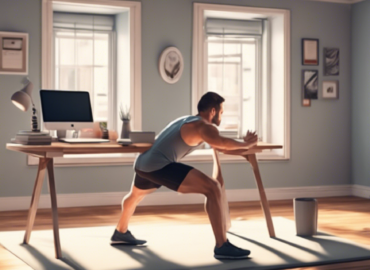The Comprehensive Workout Regimen for Beginners Working From Home

In today’s fast-paced world, many individuals find themselves working from home. While this arrangement offers convenience and flexibility, it can also lead to a sedentary lifestyle and a lack of physical activity. To combat these challenges and maintain a healthy lifestyle, it is essential to establish a comprehensive workout regimen. In this article, we will outline a 1500-word guide for beginners working from home.
FREE eBook: A Guide on How to Run a Home Business or Remote Job
Benefits of Regular Exercise
Before delving into the workout regimen, let’s briefly explore the benefits of regular exercise. Engaging in physical activity on a consistent basis offers numerous advantages, including:
Increased energy levels
Improved mental health and reduced stress
Enhanced productivity and focus
Strengthened immune system
Better sleep quality
Weight management
Reduced risk of chronic diseases
By incorporating regular exercise into your daily routine, you can experience these benefits and improve your overall well-being.
Setting Goals
To kick-start your workout regimen, it is crucial to set specific and attainable goals. Begin by determining your fitness objectives, whether they involve weight loss, muscle gain, or overall endurance improvement. Setting realistic goals will help you stay motivated and track your progress effectively.
Creating a Schedule
Next, establish a workout schedule that works best for your daily routine. Working from home provides flexibility, making it easier to fit in exercise sessions. Determine the time of day that suits you the most and ensure you allocate sufficient time for each workout session. Consistency is key when establishing a workout routine, so aim for at least three to five sessions per week.
Warm-up and Cool-down
Before diving into your workout, it is essential to warm up your muscles and prepare your body for physical activity. A warm-up session should last around 5-10 minutes and include exercises like jogging in place, jumping jacks, or stretching. Cooling down after your workout is equally important to gradually decrease your heart rate and prevent muscle soreness. Stretching exercises are ideal for a cool-down routine.
FREE eBook: A Guide on How to Run a Home Business or Remote Job
Cardiovascular Exercise
Cardiovascular exercise is crucial for improving heart health, increasing stamina, and burning calories. There are several options that beginners can consider:
Brisk Walking: A simple yet effective way to get your heart rate up is by going for a brisk walk in your neighborhood or local park. Aim for at least 30 minutes of walking per session.
Cycling: If you have access to a stationary bike, cycling is an excellent low-impact option. Start with a comfortable resistance level and gradually increase intensity as your fitness improves.
Jumping Rope: An affordable and convenient cardio workout, jumping rope is perfect for indoor exercise. Begin with shorter intervals and gradually increase the duration as you build endurance.
Dancing: Whether you follow an online dance tutorial or freestyle in your living room, dancing provides an enjoyable and effective cardio workout.
Remember to start each cardio session with a warm-up, gradually increase intensity, and end with a cool-down routine.
Strength Training
Incorporating strength training into your workout regimen is essential for building muscle, improving bone density, and boosting metabolism. Beginners can start with bodyweight exercises before progressing to weights or resistance bands. Here are some exercises to consider:
Push-ups: This exercise targets the chest, shoulders, and triceps. Begin with modified push-ups (knees on the floor) if full push-ups are too challenging.
Squats: Squats work the lower body, including the quadriceps, hamstrings, and glutes.
Focus on maintaining proper form to avoid injury.
Lunges: Lunges target the quadriceps, hamstrings, and glutes. Start with stationary lunges and progress to walking or reverse lunges.
Plank: Planks engage the core muscles, including the abdominal muscles and lower back. Begin with shorter intervals and gradually increase your holding time.

Dumbbell Exercises: If you have access to dumbbells, consider incorporating exercises like bicep curls, overhead presses, and bent-over rows into your routine.
Perform each exercise for 10-15 repetitions and aim for two to three sets. Take breaks between sets and listen to your body to avoid overexertion.
FREE eBook: A Guide on How to Run a Home Business or Remote Job
Flexibility and Mobility
Flexibility and mobility exercises are often neglected but are crucial for maintaining joint health and preventing injuries. Consider adding the following exercises to your regimen:
Yoga: Practicing yoga enhances flexibility, balance, and mindfulness. There are numerous online resources and apps available for beginners.
Stretching: Perform static stretches after each workout session to improve flexibility and prevent muscle tightness. Focus on major muscle groups such as the hamstrings, quadriceps, and shoulders.
Incorporating Workouts Into Your Daily Routine
Working from home allows for greater flexibility in incorporating workouts into your daily routine. Here are some tips to help you seamlessly integrate exercise into your work-from-home lifestyle:
Schedule Breaks: Set regular intervals throughout your workday to take short breaks and engage in physical activity. This could include a quick walk around the block, stretching exercises, or even a brief yoga session.
Create a Home Gym: If you have the space and budget, consider setting up a designated area in your home for exercise equipment. This could include a treadmill, stationary bike,
or weights. Having these resources readily available will make it easier to fit in workouts during breaks or after work hours.
Join Online Fitness Classes: Take advantage of the wide variety of online fitness classes available. Many platforms offer live or pre-recorded workout sessions that you can participate in from the comfort of your own home. Whether it’s high-intensity interval training (HIIT), Pilates, or dance workouts, there is something for everyone.
Make Use of Household Items: Don’t let a lack of equipment deter you from exercising. Get creative and use household items as substitutes. For example, water bottles can be used as dumbbells, a chair can serve as a support for step-ups or tricep dips, and a towel can be used for resistance exercises.
Set Reminders: It’s easy to get caught up in work and forget about exercise. Set reminders on your phone or computer to prompt you to take breaks and engage in physical activity. This will help you maintain consistency and ensure you don’t neglect your workout regimen.
FREE eBook: A Guide on How to Run a Home Business or Remote Job
Stay Hydrated: Drinking enough water throughout the day is crucial for maintaining good health and energy levels. Keep a water bottle at your desk and make a habit of sipping on it regularly. Staying hydrated will support your workouts and overall well-being.
Track Your Progress: Keep a workout journal or use a fitness tracking app to record your exercises, sets, and reps. Tracking your progress not only helps you stay motivated but also allows you to monitor improvements in strength, endurance, and flexibility over time.
Stay Active Outside of Work Hours: In addition to incorporating exercise into your work breaks, make an effort to stay active outside of work hours as well. Go for a walk or run in the evenings, participate in recreational activities with friends or family, or engage in hobbies that require physical movement.
Remember that consistency is key when it comes to any workout regimen. Even if you have a busy work schedule, finding small pockets of time throughout the day to move your body can make a significant difference in your overall health and well-being.
Conclusion
In conclusion, working from home provides an opportunity to prioritize your physical health by establishing a comprehensive workout regimen. By setting goals, creating a schedule, incorporating cardiovascular exercise, strength training, flexibility and mobility exercises, and seamlessly integrating workouts into your daily routine, you can maintain a healthy, active lifestyle
while working remotely. Embrace the flexibility that working from home offers and make physical activity a priority for your overall well-being and productivity.
Note: The information provided in this article is for educational purposes only and should not be interpreted as medical advice. It is always recommended to consult with a healthcare professional before starting any new exercise program.
FREE eBook: A Guide on How to Run a Home Business or Remote Job



